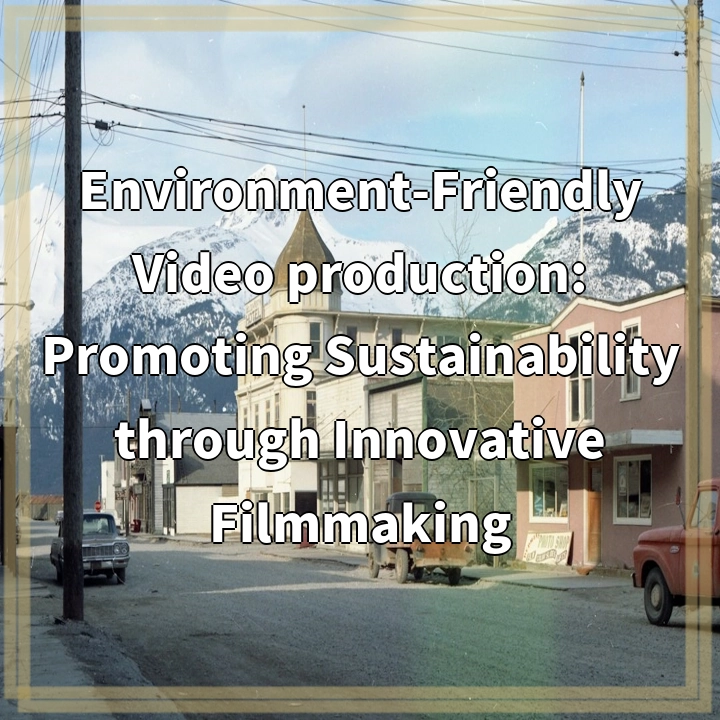
What it is:
Environment-friendly video production refers to the practice of producing films and video content in a sustainable and eco-conscious manner. It involves minimizing the negative environmental impact throughout the entire filmmaking process, from pre-production to post-production and beyond. This approach aims to reduce waste, conserve energy, and promote the use of renewable resources, while still delivering high-quality and impactful visual storytelling.
Real-World Problems:
Despite the growing awareness and concern for environmental issues, video production still poses several challenges that can contribute to negative environmental impacts. Here are some real-world problems associated with traditional video production methods:
1. Carbon Footprint:
Video production requires various equipment, transportation, and energy consumption, all of which contribute to greenhouse gas emissions and carbon footprint. This includes the use of fossil fuel-powered vehicles for transportation, electricity consumption on set and in studios, and the manufacturing and disposal of equipment and props.
2. Plastic Waste:
Filmmaking often involves the use of single-use plastics, such as water bottles, food containers, and packaging materials. These items contribute to the global plastic waste problem and can end up in landfills or ecosystems, leading to pollution and harm to wildlife.
3. Resource Intensity:
The production of audiovisual content requires a significant amount of resources, including raw materials, energy, and water. This can lead to the depletion of natural resources, habitat destruction, and increased strain on ecosystems.
4. Toxic Chemicals:
Certain filmmaking processes, such as film development and special effects, involve the use of chemicals that can be harmful to both the environment and human health. These chemicals can contaminate water sources and soil, and their improper disposal can cause long-term damage.
5. Waste Generation:
Video production generates a significant amount of waste, including leftover materials, packaging, and discarded set pieces. Without proper waste management practices, this waste can end up in landfills, contributing to pollution and resource depletion.
6. Lack of Awareness and Action:
One of the major problems in the film industry is the lack of awareness and action regarding sustainable practices. Many production companies and individuals prioritize convenience and cost-efficiency over environmentally friendly alternatives. This mindset hinders the adoption of sustainable practices and the reduction of environmental impacts in the industry.
Addressing these real-world problems associated with traditional video production methods requires a shift towards more environmentally friendly practices. In the next section, we will explore innovative approaches and solutions that promote sustainability in video production.

Solutions for Environment-Friendly Video Production:
Adopting sustainable practices in video production can help mitigate the environmental impact of filmmaking. Here are some innovative approaches and solutions to promote sustainability in the industry:
1. Green Energy and Efficient Equipment:
Utilizing renewable energy sources, such as solar or wind power, can significantly reduce carbon emissions during production. Additionally, using energy-efficient lighting, camera equipment, and other technologies can help minimize energy consumption without compromising the quality of the final product.
2. Waste Reduction and Recycling:
Implementing comprehensive waste management systems that prioritize waste reduction, recycling, and proper disposal is crucial. This includes encouraging the use of reusable materials, minimizing packaging waste, and establishing recycling programs on set and in production studios.
3. Sustainable Set Design and Props:
Choosing sustainable materials for set design and props can significantly reduce the environmental footprint. Opting for eco-friendly and non-toxic alternatives, such as recycled or biodegradable materials, can help minimize waste generation and harmful chemical use.
4. Responsible Resource Management:
Efficiently managing resources, such as electricity and water, is vital for sustainability. This involves using energy-saving technologies, implementing water conservation measures, and considering the environmental impact when sourcing materials and locations for filming.
5. Collaboration and Education:
Promoting a culture of sustainability within the film industry requires collaboration and education. Production companies, filmmakers, and professionals should actively share knowledge, experiences, and best practices to inspire and encourage others to adopt sustainable approaches. Industry-wide workshops, conferences, and networking events can play a crucial role in fostering awareness and education.
6. Engaging Audiences:
Films and videos have the power to create awareness and inspire change. By incorporating environmental themes and messages into storytelling, filmmakers can encourage their audiences to take action and adopt more sustainable lifestyles. This can help amplify the impact of environment-friendly video production beyond the industry itself.
By implementing these solutions and promoting sustainable practices, the film industry can take significant strides towards reducing its environmental impact. Environment-friendly video production not only benefits the planet but also sets a positive example for other industries and future generations.















